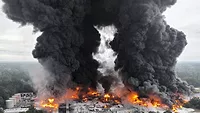Sri Lanka Water Supply Still Suffers Effects of 2004 Tsunami
Sri Lanka's coastal drinking water supply continues to suffer the effects of the December 2004 tsunami, which caused major death and destruction in the region. Much of the island nation's coastal area relies on wells, usually hand dug and relatively shallow. Some 40,000 such wells, each typically serving several families, were destroyed or contaminated by the tsunami. The continued sustainability of the aquifers that supply such wells is in doubt, due to continued saltwater contamination, erosion of beaches, and other human impacts, such as sand mining, increased pumping and pollution, according to an international team of scientists and engineers.
The 14-member team from the United States, Sri Lanka and Denmark, reports its findings in a paper scheduled for publication in the American Geophysical Union journal Water Resources Research. During investigations in Sri Lanka from February through September 2005, they found that the tsunami had affected coastal drinking water sources in several ways.
First, the tsunami itself, which reached up to 0.9 miles inland, poured seawater, along with other contaminants, directly into the open dug wells, rendering those that were not destroyed unusable. In some areas, as many as four large tsunami waves struck, with the second in the series often the largest. Aside from contamination of wells, large quantities of seawater penetrated from the flooded surface of the land through porous layers below and into the aquifer.
Further, efforts to restore wells by pumping out seawater sometimes were apparently counterproductive, as excessive pumping may have allowed more seawater to enter the aquifer from below. This pumping also caused many wells to collapse, as their walls were not reinforced. Finally, contaminated water that was pumped out of wells often was discharged in places that permitted contaminants to seep back into the aquifer and again into the wells.
The researchers, led by Prof. Tissa Illangasekare of the Center for Experimental Study of Subsurface Environmental Processes, located at the Colorado School of Mines, found that one anticipated consequence of the disaster did not materialize. They write that fears of outbreaks of waterborne disease were not realized, due to public awareness of the need to disinfect wells and to practice good personal and food hygiene.
Although some of the affected coastal aquifers in Sri Lanka are composed of ancient limestone deposits, especially in the north of the country, most coastal ground water is stored in sandy aquifers that are replenished by rainwater, especially during the October-to-February monsoons. This recharge has been slow in many of the most-affected areas, as they did not receive substantial rainfall for almost a year. The December 2005 monsoon rains were substantial, but the researchers say it will take several more monsoon seasons - they do not know how many - for the aquifers to recover. In collaboration with the American, Danish and Sri Lankan scientists, a group of researchers at the International Water Management Institute based in Sri Lanka currently is conducting long-term monitoring studies at selected sites.
The researchers say that since March 2005, salinity levels have declined slowly, if at all, in many of the wells that continued to be pumped. They note that planning is underway to provide piped water to many coastal villages, to supplant the individual, and vulnerable, open dug wells. Other social responses include plans for expansion of centralized sewage collection, proposed setbacks for housing along coastlines, and the use of new modeling techniques for integrated management of surface water and ground water for sustainable water resources.
Around the world, devastating floods can be caused by more than tsunamis, the researchers note, including storm surges, hurricanes or cyclones, and rising sea level. They urge hydrologists to participate in the planning of emergency planning procedures that could greatly reduce human suffering. Documenting the hydrologic impacts of such disasters is, they say, the first step toward developing internationally recognized emergency guidelines for treating sources of contaminated water supplies and for long-term and planning tools for managing coastal ground water in areas affected by seawater inundation.
Looking for a reprint of this article?
From high-res PDFs to custom plaques, order your copy today!





